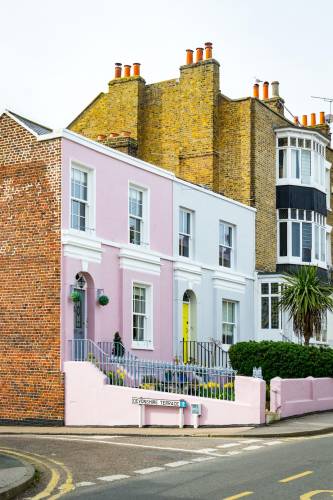Chesterton’s Nick Barnes on London Property 2021
Repeated lockdowns have had an immeasurable impact on individual lives, as well as our collective habits and culture. Our property habits are no exception – we spoke to Nick Barnes, Head of Research at Chestertons, to get his insight into the London market.
Nick takes a look back on the pandemic property market so far, as well as what the future might hold for those looking to make a move in the London property market this year.
General themes and the evolution of the market during lockdown
One thing about the London housing market, Nick tells us, is that there is no homogenous market so to speak. There are big differences by location, and between the mainstream market and the prime market, however you define it.
And London itself has a different dynamic from the rest of the country – something to bear in mind if you are researching a potential move.
After the unprecedented events of last year, Chestertons have seen some significant changes to the market, with distinct differences between the prime and mainstream markets.
“The broad pre-Covid situation was that prices had generally been falling in prime locations for several years, although the rate of decline had slowed by the time of the first national lockdown.”
“In contrast, in the mainstream market, prices had been flat or falling for much of 2019, but had begun to rise from December and continued to rise in the first quarter of 2020. This was due to a combination of the “Boris bounce” – the landslide General Election result and closure on Brexit — and low interest rates, but also a large mismatch between supply and demand,” Nick says.
"However, towards the end of March, the entire market was effectively shut down for around 7 weeks.
“Despite the impact of the coronavirus, the housing market, both prime and mainstream, proved unexpectedly resilient. At Chestertons, in our prime locations, we saw a 31% increase in sales between June and December last year compared to the same period in 2019, which was remarkable.”
“In contrast, across Greater London, we estimate sales fell by around 25% over the same period, which is equally dramatic. Two things stand out for me as to why that was – one is affordability, which has worsened, particularly in London - notwithstanding very attractive mortgage interest rates. A major issue here is first time buyers struggling to put together a deposit. Even if you can get a 95% mortgage, the average house price in London (a shade under £500,000 according to the Land Registry) means that scraping together a deposit is still beyond most first-time buyers without help from the Bank of Mum and Dad or some kind of windfall. The rise in unemployment and furloughed staff also affected households’ ability and confidence to proceed with house purchases.”

Other factors shaping the market
When the housing market re-opened in mid-May, buyers rushed back to the market, Nick tells us, spurred on by the stamp duty holiday, low mortgage interest rates, and in prime markets, by a 53% rise in supply. Buyers in prime locations were also able to take advantage of the more attractive prices on offer which had again dropped sharply following the first lockdown.
A lot of this demand had been waiting to be released before Covid arrived, but a major driving factor was most certainly what Nick calls the lockdown experience, which has created a new type of demand.
“There were huge increases in demand for outside space, gardens, and a dedicated room for home working. We’ve also seen a desire to move before further restrictions were imposed, so throughout the year, those people who were financially secure and confident in their job stability, were inclined to get a hurry on to move, in case, and as eventually turned out, further lockdowns happened.”
With a such a strong start to the year – Chestertons has recorded 57% more sales in the year to February – it is unlikely these numbers will be sustained in the long term. They key factors adding to slowing demand, Nick says, involve frustrations over repeated lockdowns, as well as employment instability, and delays at different points in the transaction process as lenders, surveyors and solicitors have struggled to cope with the sheer volume of work on top of the operational difficulties caused by the coronavirus.
The positive news, however, is that some issues which had been frustrating sellers, such as cladding and leasehold issues, are starting to be addressed by the government.
Looking forward: pressure from stamp duty and capital gains tax?
“It would be great news if the stamp duty deadline were to be extended until the end of June – but actually, whenever the due date falls, we’re going to be faced with the same situation. Whenever it ends, we’re still going to reach a point where a lot of sales potentially won’t get through.”
“In the event that these deals fall through, both parties will have already spent money on the transaction, which will essentially be non-recoverable costs, as well as the emotional cost of having your dream home move fall through.”
“Inevitably I think that when the Stamp Duty holiday eventually ends there will likely be a short-term downward impact on prices and transaction numbers. The impact will be a lot less on prime markets – by definition if you can afford prime prices, you won’t be as heavily affected by the discounts.”
And reforms to capital gains tax may also be something for investors and second-home-owners to consider – if the most far reaching suggestions are implemented, there may be another rush of sales to beat that deadline, similar to what we have seen with the SDLT deadline, Nick says.
What are the locations to watch for prospective buyers?
A number of London sub-markets have been much more popular than others recently, with buyers being driven to the suburbs by a need for more space and taking advantage of lower prices away from Central London. South West London has been particularly popular since last summer, Nick tells us.
“Markets like Barnes, East Sheen and Kew have the typical stock profile which is attracting buyers – they have a high proportion of nice, large properties with attractive gardens – and they’re located in leafy suburbs with good schools and easy access to Central London.”
While for many people, the prospect of working from home for a higher proportion of the week is a long term one, therefore driving buyers out of London, this is not the case for everyone.
“We have seen a small number of people wanting to move closer to work, in order to avoid having to use public transport, because they’re worried about Covid – an interesting contra-cyclical demand driver.”
And, while international buyers are currently less present in many London submarkets, especially Central London where they make up over 50% of the demand in these areas in a typical year – price conscious domestic buyers have been taking advantage of lower competition levels.
The positive outlook
The last year has arguably been the most challenging ever for most of us but there is definite light at the end of the coronavirus tunnel with the announcement of the Government’s Roadmap, which should trigger recovery in the wider economy. Buyer and seller confidence will improve, aided by the extension of the Stamp Duty holiday and the introduction of the new Mortgage Guarantee scheme, and property sales should pick up again across the board.












